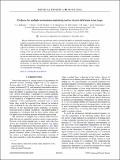Evidence for multiple mechanisms underlying surface electric-field noise in ion traps
Author(s)
Slichter, D. H.; Sage, J. M.; Sedlacek, Jonathon; Stuart, Jules; Bruzewicz, Colin D.; McConnell, Robert P.; Sage, Jeremy M.; Chiaverini, John; ... Show more Show less
DownloadPhysRevA.98.063430.pdf (1.550Mb)
PUBLISHER_POLICY
Publisher Policy
Article is made available in accordance with the publisher's policy and may be subject to US copyright law. Please refer to the publisher's site for terms of use.
Terms of use
Metadata
Show full item recordAbstract
Electric-field noise from ion-trap electrode surfaces can limit the fidelity of multiqubit entangling operations in trapped-ion quantum information processors and can give rise to systematic errors in trapped-ion optical clocks. The underlying mechanism for this noise is unknown, but it has been shown that the noise amplitude can be reduced by energetic ion bombardment, or “ion milling,” of the trap electrode surfaces. Using a single trapped ⁸⁸Sr⁺ ion as a sensor, we investigate the temperature dependence of this noise both before and after ex situ ion milling of the trap electrodes. Making measurements over a trap electrode temperature range of 4 K to 295 K in both sputtered niobium and electroplated gold traps, we see a marked change in the temperature scaling of the electric-field noise after ion milling: power-law behavior in untreated surfaces is transformed to Arrhenius behavior after treatment. The temperature scaling becomes material-dependent after treatment as well, strongly suggesting that different noise mechanisms are at work before and after ion milling. To constrain potential noise mechanisms, we measure the frequency dependence of the electric-field noise, as well as its dependence on ion-electrode distance, for niobium traps at room temperature both before and after ion milling. These scalings are unchanged by ion milling.
Date issued
2018-12Department
Lincoln Laboratory; Massachusetts Institute of Technology. Department of PhysicsJournal
Physical Review A
Publisher
American Physical Society
Citation
Sedlacek, J. A. et al. "Evidence for multiple mechanisms underlying surface electric-field noise in ion traps." Physical Review A 98, 6 (December 2018): 063430 © 2018 American Physical Society
Version: Final published version
ISSN
2469-9926
2469-9934